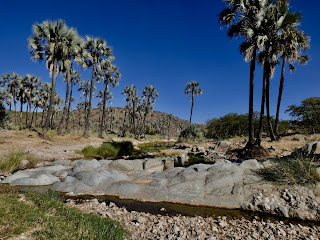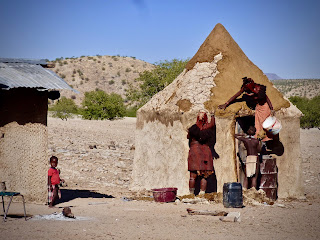On the way to Etosha
June 18
The first Himba settlements in Namibia were in the early 16th century when these tribal people crossed over the Angolan border. At that time they were part of the Herero tribe, but moved south at the end of the 19th century when a bovine epidemic killed off most of the cattle, a mainstay of Herero existence. A split developed between the groups and the Himba tribe became a reality, developing its own identity and way of life.
The tribe lives a sheltered, traditional existence and, in order to reach them, our jeep had to traverse rocks and streams and very bumpy roads. We were graciously greeted by a few young women who were repairing the roof of a hut; this being a female job. They were warm and welcoming and happy to pose for pictures in between plastering the roof with red ochre clay. The women, actually, coat their bodies and hair with the pounded ochre stone; this keeps their skin moist and also serves as a sun block and, I later read, clearly separates the men from the women. Very early days of drought also began a tradition of only the men bathing themselves with water. The women, however, take a daily “smoke bowl” whereby they burn charcoal, herbs, and leaves of commiphora trees; they bow over the smoke and the perspiration ultimately cleanses their bodies.
Although the Himba are clearly sheltered from the rest of the world, there is an English speaking teacher in the tribe who is introducing the children to just a bit of a more modern existence. Time will tell what the future brings.











No comments:
Post a Comment